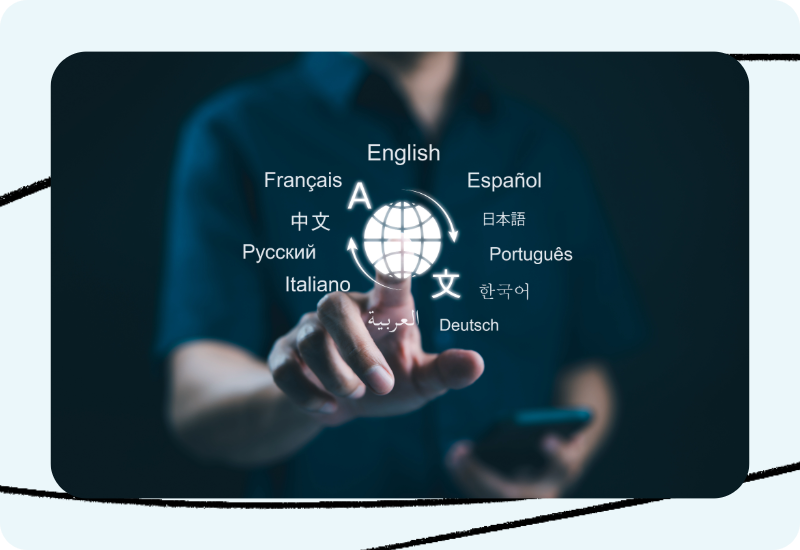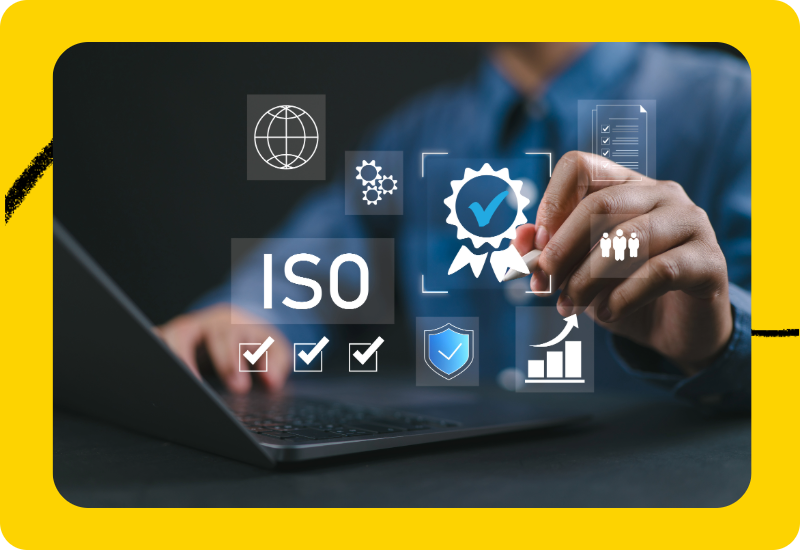If you’re defaulting to onshore language resources because they “just feel safer,” you’re not alone. Many of our customers feel the same way.
It’s an understandable impulse. And yet, the most common concerns about offshore linguists (whether translators or interpreters) are based on assumptions, not actual outcomes. With the right infrastructure, offshore linguists can meet the same compliance and quality standards as onshore resources, often with greater flexibility, better cost, and higher speed.
In other words, when you make geography your key requirement, you may miss out on opportunities for better coverage, faster turnaround times, and more efficient use of your resources.
Here, we’ll walk through the most persistent misconceptions we hear about offshore language support and explain what’s really at stake when those beliefs go unchallenged.
Misconception #1: Offshore Work is Less Secure
If you work in healthcare, government, or other regulated sectors, regulatory compliance and security drive nearly every decision. That often leads to questions about the safety of using offshore linguists.
But here’s the truth: Location doesn’t create compliance risks. Weak systems do.
At BIG, we’ve built secure infrastructure that supports offshore resources without compromising compliance, privacy, or peace of mind. Our customers, especially in regulated industries, often ask us how we do it. In a nutshell, security is built into the workflow.
Our offshore linguists operate under the same strict protocols as our onshore teams, including:
• HIPAA and FERPA compliance for regulated industries
• ISO 27001 certification for information security
• SOC 2 Type II attestation, earned through a rigorous months-long audit that validates the strength and reliability of our security and privacy controls
All linguists access files through Secure File Transfer Protocol (SFTP) and our Virtual Desktop Infrastructure (VDI), which keeps data inside U.S.-based systems and prevents any local storage or device-based downloads.
These controls make sure sensitive content stays within secure environments, regardless of where the linguist is based.
For healthcare clients where PHI is of concern, we go a step further. As part of our quick-turn, high-volume LanguageExpress™ service, we use AI-powered PHI scrubbing to remove personally identifiable data from medical documents before they’re sent for translation. This protects patients and keeps you compliant with HIPAA, CCPA, CPRA, and other privacy regulations.
Once translation is complete, the documents return to U.S. systems for final reintegration of the redacted data, keeping PHI protected at every stage of the process.
We don’t just “train” linguists to follow compliance protocols; we design systems that make secure workflows the default. Whether it’s document translation or live interpreting, every access point is governed by layered protections, monitored usage, and technical safeguards.
By choosing the right partner, offshore linguist support can be just as compliant, just as secure, and far more scalable than relying on U.S.-based teams alone.
Misconception #2: Offshore Linguists Mean Lower Quality
Our customers sometimes worry that offshore linguists won’t meet the same quality standards as onshore teams, and it’s easy to see why, given the mixed reputation of offshore customer service. But working with offshore linguists is a completely different ballgame.
In fact, working with offshore linguists can actually mean higher quality, not lower.
That’s because successful communication isn’t just about words alone. Almost as important is the cultural aspect. Offshore interpreters and translators are cultural experts, living in the community they represent in their work. This deep cultural competency makes them better linguists, more capable of adapting messages for their audience so that the meaning comes through clearly.
And by widening our recruitment reach, we’ve significantly expanded the pool of highly qualified interpreters and translators available to our clients. When recruitment is limited by geography, it can prevent access to the best-fit linguist for a specific assignment. A globally distributed model ensures we can source the strongest talent, those with the right dialectal fluency, credentials, and subject matter expertise, wherever they are located.
And we have a process in place to guarantee quality service, no matter where your linguists are.
How We Verify Subject-Matter Expertise and Native Fluency for Offshore Translators
First, we verify subject matter expertise and native fluency, no matter where the resource sits. All BIG translators, onshore and offshore, are held to the same high bar. Every linguist must meet or exceed the qualifications described in ISO 17100, the international standard for translation services. That includes a recognized translation degree (or equivalent experience) and subject-matter expertise in their area of specialization, such as medical, legal, or technical fields. For ISO 17100–compliant workflows, offshore translators follow the same structured T+E (Translation + Editing) or T+E+P (Translation + Editing + Proofreading) process as onshore linguists, including independent revision by a second qualified linguist.
Our recruitment and vetting process is led by our dedicated Vendor Management Office (VMO) and includes:
• Initial screening and identity verification
• Credential and portfolio reviews
• Test translations, reviewed by senior linguists
• Signed NDAs and data-protection agreements
• Training on client-specific terminology, style guides, and use of our secure platform, LanguageVault™
Once onboarded, to make sure the output is of high quality, we use a T+E+P workflow (translation, editing, and proofreading) supported by automated QA tools, performance scoring, and regular audits by internal quality managers.
We also maintain a continuous feedback loop through our Quality Management System (QMS). Any issues that arise are documented and addressed through retraining or corrective action, promoting accountability and ongoing improvement.
And thanks to our global team structure, we can manage real-time QA and project communication across time zones, keeping work moving without delays and helping clients meet tight deadlines more reliably.
How We Recruit, Qualify, and Vet Interpreters, Including Those Located Offshore
Onshore or off, all interpreters move through the same structured pathway. Our global Interpreter Onboarding team follows a standardized recruitment process that includes:
• Language proficiency testing (ACTFL or CEFR-aligned)
• Scenario-based interpreting exams covering healthcare, legal, and community topics
• Background screening and identity verification
• HIPAA and confidentiality training
• System and environment audits for offshore interpreters to verify secure, distraction-free setups
Once onboarded, interpreters are continuously evaluated through:
• Monthly call monitoring by certified QA reviewers
• Performance scoring based on accuracy, tone, and adherence to protocol
• Retraining or suspension in the case of non-conformance
• Ongoing professional development and periodic re-testing
Interpreter performance is tracked through InterpVault™, our secure interpretation management platform, which enables real-time QA oversight for consistent quality across all languages and locations.
In fact, we continually assess every aspect of our OPI performance against 10 checkpoints, including everything from response times to call monitoring to customer service.
Misconception #3: Different Time Zones are a Problem
Some people think that offshore teams won’t be available when you need them to be or able to keep up within their timelines.
Actually, the opposite is true.
With offshore teams, you can get 24/7 production, real-time QA, and wider availability across languages, time zones, and service types.
How Offshore Translators Help You Translate More, Faster
For translation projects, offshore resources extend your production window. With teams operating across time zones, files can be translated, reviewed, and returned while U.S.-based teams are offline, keeping work moving through evenings, weekends, and holidays.
At BIG, we build mandatory overlap windows into every project and manage all communication within LanguageVault™. This enables shared visibility, continuous QA, and zero “dead zones” in translation production.
The result is faster delivery and proactive problem-solving, even on high-volume or short-notice requests.
How Offshore Interpreters Give You Better Coverage
Interpreter availability is one of the most pressing issues in language access. Offshore support helps solve it. With a broader global talent pool, BIG Language Solutions can connect you to qualified interpreters faster and more consistently.
Through our secure InterpVault™ platform, we provide:
• 20-second average connect times
• 24/7/365 availability across 300+ languages
• Skill-based routing for faster, more accurate assignments
• 99.999% uptime for uninterrupted access
• Higher fill rates and fewer missed or delayed calls
Whether it’s document turnaround or live interpreter access, offshore support doesn’t slow you down; it helps you keep up.
Misconception #4: The Only Advantage of Offshore Linguists Is Cost
While it’s true that offshore resources can often be more cost-effective, focusing on price alone misses the bigger picture. In practice, offshore linguists offer advantages that go well beyond budget.
Working with a global talent pool provides:
• Access to more specialized skills
• Broader language coverage, and
• Greater scalability when demand spikes.
Whether it’s ramping up support when needed, covering hard-to-staff languages, finding top-quality linguists, or managing fluctuating volume, offshore teams give you more flexibility to adapt without overextending your local resources.
They also allow you to align the right work with the right expertise, using offshore support for high-volume or standardized tasks while reserving highly specialized or sensitive assignments for linguists with deep subject-matter knowledge. For example, you might need a translator with a background in computer engineering for technical documentation, or a medically trained interpreter who knows something about a new medical case study. Having access to a global network makes it easier to find the right resource, wherever they’re located. This approach makes your entire program more efficient.
There are four clear advantages:
1. Broader access to qualified linguists across all languages: Offshore locations provide access to a much larger pool of qualified interpreters overall, across all language pairs and specialties.
2. Cheaper rates: Offshore resources can lower per-word and per-minute costs without compromising professionalism or accuracy, offering more competitive rates.
3. Faster connections with over-the-phone interpreters: A wider global pool increases the likelihood of finding the right interpreter immediately, improving speed and reducing missed or delayed calls for faster connect times.
4. Higher quality: Offshore linguists are more likely to be native or native-fluent speakers, resulting in higher linguistic quality.
If you need to improve a struggling onshore interpreting program in particular, adding in offshore resources is one of the most effective ways to do so. The combination of better availability, faster connections, and deeper language expertise can quickly address common pain points like long wait times and inconsistent coverage.
The Real Risk of Offshore Linguists (Hint: It’s Not What You Think)
The real risk of offshore linguists is not using them when your organization could benefit.
You may be paying more to feel safer. But are you seeing better results? Are you getting the quality, availability, and cost-effectiveness you need to meet your goals?
When supported by strong infrastructure, real-time oversight, and a proven quality framework, offshore linguists are a strategic asset.
If your language program is feeling stretched, or if you’re re-evaluating your vendor partnerships, it might be time to take a second look at your staffing model. Rethinking your assumptions could lead to better access, higher efficiency, and smarter use of resources, without increasing your risk.
If you’re evaluating vendors or refining your translation or interpretation strategy, we’re happy to share what we’ve seen work and help you find the best-fit model for your organization. Contact us to discuss what the right mix of resources could deliver for you.





